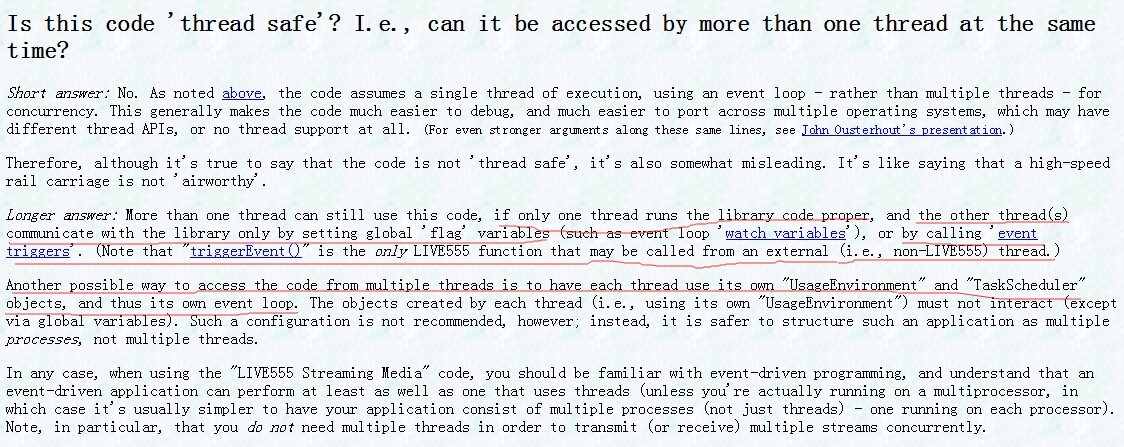上一篇介绍了Live555如何实现录像功能,我录的是H264编码的视频文件。在《Live555的基本介绍》这一篇中,我介绍说把mp3文件放到live/mediaServer目录下,然后使用Live555流化,就可以通过vlc去点播该文件。那么我们录好的h264文件能否被Live555流化然后使用VLC点播呢?经试验,发现是不行的。
然后我就对比VLC去请求Live555流化mp3文件和h264文件的过程,发现了原因:在请求h264文件时返回的SDP信息中,总出现"a=range:npt=0-",而请求mp3文件时返回的SDP信息中,npt后面是0到一个具体的数字,即指定了该ServerMediaSubsession的时间长度。在ServerMediaSession::generateSDPDescription函数中,我们找到与此相关的内容:
1 // Unless subsessions have differing durations, we also have a "a=range:" line: 2 float dur = duration(); 3 if (dur == 0.0) { 4 rangeLine = strDup("a=range:npt=0- "); 5 } else if (dur > 0.0) { 6 char buf[100]; 7 sprintf(buf, "a=range:npt=0-%.3f ", dur); 8 rangeLine = strDup(buf); 9 } else { // subsessions have differing durations, so "a=range:" lines go there 10 rangeLine = strDup(""); 11 }
也就是说,duration函数返回值为0,才会出现"a=range:npt=0-",表示此ServerMediaSession的持续时间未知(不是表示此ServerMediaSession的持续时间为0)。
1 float ServerMediaSession::duration() const { 2 float minSubsessionDuration = 0.0; 3 float maxSubsessionDuration = 0.0; 4 for (ServerMediaSubsession* subsession = fSubsessionsHead; subsession != NULL; 5 subsession = subsession->fNext) { 6 // Hack: If any subsession supports seeking by 'absolute' time, then return a negative value, to indicate that only subsessions 7 // will have a "a=range:" attribute: 8 char* absStartTime = NULL; char* absEndTime = NULL; 9 subsession->getAbsoluteTimeRange(absStartTime, absEndTime); 10 if (absStartTime != NULL) return -1.0f; 11 12 float ssduration = subsession->duration(); 13 if (subsession == fSubsessionsHead) { // this is the first subsession 14 minSubsessionDuration = maxSubsessionDuration = ssduration; 15 } else if (ssduration < minSubsessionDuration) { 16 minSubsessionDuration = ssduration; 17 } else if (ssduration > maxSubsessionDuration) { 18 maxSubsessionDuration = ssduration; 19 } 20 } 21 22 if (maxSubsessionDuration != minSubsessionDuration) { 23 return -maxSubsessionDuration; // because subsession durations differ 24 } else { 25 return maxSubsessionDuration; // all subsession durations are the same 26 } 27 }
看一下ServerMediaSession::duration函数,发现ServerMediaSession的duration取决于各个ServerMediaSubsession的duration。那我们再看一下ServerMediaSubsession的duration函数:
1 float ServerMediaSubsession::duration() const { 2 // default implementation: assume an unbounded session: 3 return 0.0; 4 }
可以看到默认的实现是返回0,而对于H264视频文件对应的ServerMediaSubsession具体类是H264VideoFileServerMediaSubsession,在该类中没有找到覆盖duration的实现,因此对于H264视频文件duration函数返回0。而对于mp3文件,我们看一下MP3AudioFileServerMediaSubsession类中关于duration的实现:
1 float MP3AudioFileServerMediaSubsession::duration() const { 2 return fFileDuration; //返回的是fFileDuration,这个值由MP3FileSource得到 3 }
后来发现对于mkv文件,Live555也是支持点播的,那么我又去看了一下MatroskaFileServerMediaSubsession类关于duration的实现:
1 float MatroskaFileServerMediaSubsession::duration() const { return fOurDemux.fileDuration(); }
总之,对于mp3文件和mkv文件,druation函数都有具体的实现,而对于h264文件,使用的是默认的实现(返回0)。后来在官网找到这么一段说明:

这段话列出了Live555支持几种播放动作(包括暂停、点播、快进、倒放)的文件类型,Seeking即点播,从中我们可以看到支持的文件类型没有h264。但是后面又提示说了如果要使这些播放动作可以用于MPEG Transport Stream file(即ts流文件,后缀名是.ts),则必须有一个index file,还提示说可以使用MPEG2TransportStreamIndexer来产生index file。
然后我在testOnDemandRTSPServer.cpp中找到了对于.ts文件的处理
1 // A MPEG-2 Transport Stream: 2 { 3 char const* streamName = "mpeg2TransportStreamTest"; 4 char const* inputFileName = "test.ts"; 5 char const* indexFileName = "test.tsx"; 6 ServerMediaSession* sms 7 = ServerMediaSession::createNew(*env, streamName, streamName, 8 descriptionString); 9 sms->addSubsession(MPEG2TransportFileServerMediaSubsession 10 ::createNew(*env, inputFileName, indexFileName, reuseFirstSource)); 11 rtspServer->addServerMediaSession(sms); 12 13 announceStream(rtspServer, sms, streamName, inputFileName); 14 }
从中可以看到,对于.ts文件的流化,Live555还需要一个.tsx文件,这个就是对应于.ts文件的index file了。然后我在live/testProgs目录下找到了MPEG2TransportStreamIndexer.cpp
1 int main(int argc, char const** argv) { 2 // Begin by setting up our usage environment: 3 TaskScheduler* scheduler = BasicTaskScheduler::createNew(); 4 env = BasicUsageEnvironment::createNew(*scheduler); 5 6 7 // Parse the command line: 8 programName = argv[0]; 9 //if (argc != 2) usage(); 10 11 char const* inputFileName = "test.ts"; 12 // Check whether the input file name ends with ".ts": 13 int len = strlen(inputFileName); 14 if (len < 4 || strcmp(&inputFileName[len-3], ".ts") != 0) { 15 *env << "ERROR: input file name "" << inputFileName 16 << "" does not end with ".ts" "; 17 usage(); 18 } 19 20 // Open the input file (as a 'byte stream file source'): 21 FramedSource* input 22 = ByteStreamFileSource::createNew(*env, inputFileName, TRANSPORT_PACKET_SIZE); 23 if (input == NULL) { 24 *env << "Failed to open input file "" << inputFileName << "" (does it exist?) "; 25 exit(1); 26 } 27 28 // Create a filter that indexes the input Transport Stream data: 29 FramedSource* indexer 30 = MPEG2IFrameIndexFromTransportStream::createNew(*env, input); 31 32 // The output file name is the same as the input file name, except with suffix ".tsx": 33 char* outputFileName = new char[len+2]; // allow for trailing x� 34 sprintf(outputFileName, "%sx", inputFileName); 35 36 // Open the output file (for writing), as a 'file sink': 37 MediaSink* output = FileSink::createNew(*env, outputFileName); 38 if (output == NULL) { 39 *env << "Failed to open output file "" << outputFileName << "" "; 40 exit(1); 41 } 42 43 44 45 // Start playing, to generate the output index file: 46 *env << "Writing index file "" << outputFileName << ""..."; 47 output->startPlaying(*indexer, afterPlaying, NULL); 48 49 env->taskScheduler().doEventLoop(); // does not return 50 51 return 0; // only to prevent compiler warning 52 } 53 54 void afterPlaying(void* /*clientData*/) { 55 *env << "...done "; 56 exit(0); 57 }
这个程序演示了如何根据一个.ts文件产生对应的.tsx文件,只要同时具有.ts文件和.tsx文件就可以实现点播了。那现在如何把h264文件转成.ts文件呢?然后我又在live/testProgs目录下惊喜发现了testH264VideoToTransportStream.cpp文件,来看看
1 int main(int argc, char** argv) { 2 // Begin by setting up our usage environment: 3 TaskScheduler* scheduler = BasicTaskScheduler::createNew(); 4 env = BasicUsageEnvironment::createNew(*scheduler); 5 6 // Open the input file as a 'byte-stream file source': 7 FramedSource* inputSource = ByteStreamFileSource::createNew(*env, inputFileName); 8 if (inputSource == NULL) { 9 *env << "Unable to open file "" << inputFileName 10 << "" as a byte-stream file source "; 11 exit(1); 12 } 13 14 // Create a 'framer' filter for this file source, to generate presentation times for each NAL unit: 15 H264VideoStreamFramer* framer = H264VideoStreamFramer::createNew(*env, inputSource, True/*includeStartCodeInOutput*/); 16 17 // Then create a filter that packs the H.264 video data into a Transport Stream: 18 MPEG2TransportStreamFromESSource* tsFrames = MPEG2TransportStreamFromESSource::createNew(*env); 19 tsFrames->addNewVideoSource(framer, 5/*mpegVersion: H.264*/); 20 21 // Open the output file as a 'file sink': 22 MediaSink* outputSink = FileSink::createNew(*env, outputFileName); 23 if (outputSink == NULL) { 24 *env << "Unable to open file "" << outputFileName << "" as a file sink "; 25 exit(1); 26 } 27 28 // Finally, start playing: 29 *env << "Beginning to read... "; 30 outputSink->startPlaying(*tsFrames, afterPlaying, NULL); 31 32 env->taskScheduler().doEventLoop(); // does not return 33 34 return 0; // only to prevent compiler warning 35 } 36 37 void afterPlaying(void* /*clientData*/) { 38 *env << "Done reading. "; 39 *env << "Wrote output file: "" << outputFileName << "" "; 40 exit(0); 41 }
这个程序又演示了如何将一个h264视频文件转成.ts格式的文件,这样把上面的两个例子程序结合起来,就可以实现H264文件的点播了。
在此,顺便说一下自己对Live555多线程编程的理解,Live555是基于事件驱动的单线程模式,每个TaskScheduler就对应一个Live555线程,那么在我们的程序中可以创建多个TaskScheduler来实现多线程。我们自己程序的其他线程和Live555线程的交互可以通过全局的flag变量或者调用triggerEvent函数。我们来看看Live555官方对于此问题的解答:
